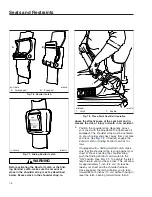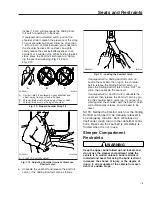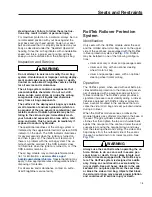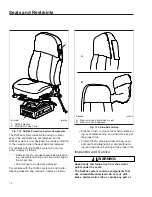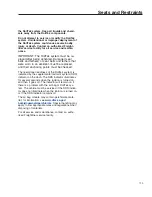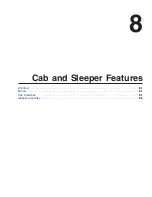
When the cab air conditioner (A/C) is on, it is normal
for the sleeper fan to operate at low speed even if
the sleeper fan switch is in the off position. This is
necessary to protect the evaporator in the sleeper
heater and air conditioner system from freezing. At
lower fan speed settings, a slight increase in airflow
levels may appear at times, as the control acts to
regulate the evaporator temperature.
When the park brake is set, any temperature or
blower speed setting changes on the bunk HVAC
unit control panel will be mimicked by the front HVAC
unit. For example, if you set bunk blower speed to HI
and the temperature to COLD, the front unit will also
operate on HI/COLD.
When the park brake is not set, the front and rear
HVAC settings function independently, unless the
bunk override button is pressed, or "minimum AC
support" is required.
Minimum AC support is when the front unit is off and
the bunk unit is set such that AC is requested (needs
the AC compressor to run). In this case, the front unit
will go into minimum AC support mode by operating
the front blower at minimum speed to prevent the
front unit evaporator from freezing up. This is also
true, if the rear unit is off and the front unit is set
such that AC is requested, in order to prevent the
bunk evaporator from freezing up.
Temperature Control Switch
The temperature control switch is used to select the
desired temperature in the sleeper. Turn the switch
counterclockwise for cool air, or clockwise for hot air.
Air Conditioning Button
The A/C cools and dehumidifies the air inside the
sleeper. Press the air conditioning button, located in
the center of the temperature control switch, to turn
the A/C on and off.
Smartway Certified Parked Heater
Operation
All vehicles equipped with diesel operated coolant
heaters are "Smartway Certified". The coolant heater
will keep the engine coolant between approximately
150 and 180°F (65 and 82°C). Heated coolant is
routed through the auxiliary HVAC heater core to
allow heater-only function of the auxiliary HVAC sys-
tem.
System Operation
1.
Turn the block heater on.
2.
Set the temperature dial to the desired heat set-
ting.
3.
Turn the HVAC blower on.
Accessory Heaters
Optional accessary heaters are available from the
factory in several configurations. Familiarize yourself
with the equipment on your specific vehicle, and fol-
low the manufacturer’s operating and maintenance
instructions.
WARNING
Do not operate fuel-operated heaters in an area
where flammable vapors, including gasoline or
diesel fumes, are present, such as at filling sta-
tions and oil depots. Turn off a fuel-operated
heater and allow it shut down completely before
entering an area where flammable gases or liq-
uids are present. Heaters continue to operate for
up to three minutes after being turned off.
Failure to observe these precautions could cause
an explosion or fire, resulting in serious property
damage, and personal injury or death.
NOTICE
Always ensure that air inlet and outlet grilles are
not restricted. Restriction of any air inlet or outlet
ports could result in damage to the auxiliary
heater.
IMPORTANT: To maintain reliable performance,
run the accessory heater for at least 15 minutes
every month to prevent fuel from degrading.
09/09/2016
f611328
3
1
2
1.
Fan Switch
2.
Temperature Control Switch
3.
Air Conditioning Button
Fig. 6.5, Sleeper Climate Control Panel
Climate Controls
6.3
Summary of Contents for NEW CASCADIA 2016
Page 1: ... NEW CASCADIA Driver s Manual Part Number STI 500 Publication Number STI 500 8 ...
Page 5: ......
Page 11: ......
Page 38: ...f611444 10 31 2016 Fig 3 23 Sample Alert Messages Instruments 3 20 ...
Page 39: ......
Page 93: ......
Page 94: ...8 Cab and Sleeper Features Windows 8 1 Mirrors 8 1 Cab Amenities 8 1 Sleeper Amenities 8 2 ...
Page 99: ......
Page 125: ......
Page 134: ...14 Steering System Power Steering System 14 1 ...
Page 145: ......
Page 146: ...16 Manual Transmissions and Clutch Eaton Fuller Manual Transmissions 16 1 Clutch 16 1 ...
Page 149: ......
Page 150: ...17 Drive Axles Interaxle Lock Tandem Axles 17 1 Driver Controlled Differential Lock DCDL 17 2 ...
Page 164: ...19 Trailer Couplings Holland Trailer Coupling 19 1 ...
Page 177: ......
Page 191: ......
Page 198: ...25 Specifications Fluids and Lubricants 25 1 ...























